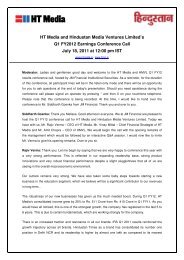Download latest annual report - HT Media
Download latest annual report - HT Media
Download latest annual report - HT Media
You also want an ePaper? Increase the reach of your titles
YUMPU automatically turns print PDFs into web optimized ePapers that Google loves.
Annual Report 2011-12<br />
54<br />
to settle the obligation, in respect of which a reliable<br />
estimate can be made. Provisions are not discounted to<br />
their present value and are determined based on best<br />
estimate required to settle the obligation at the repoting<br />
date. These are reviewed at each <strong>report</strong>ing date and<br />
are adjusted to reflect the current best estimates.<br />
Provision for expenditure relating to voluntary<br />
retirement is made when the employee accepts the<br />
offer of early retirement and such provision amount is<br />
charged to the statement of Profit and Loss in the year<br />
of provision.<br />
p) Income Taxes<br />
Tax expense comprises current and deferred tax.<br />
Current income-tax is measured at the amount<br />
expected to be paid to the tax authorities in accordance<br />
with the Income-tax Act, 1961 enacted in India and<br />
tax laws prevailing in the respective tax jurisdictions,<br />
where the company operates.The tax rates and the<br />
tax laws used to compute the amount are those that<br />
are enacted or substantively enacted at the <strong>report</strong>ing<br />
date. Current income-tax relating to items recognized<br />
directly in equity is recognized in equity and not in the<br />
statement of Profit and Loss.<br />
Deferred income-taxes reflects the impact of timing<br />
differences between taxable income and accounting<br />
income originating during the current year and reversal<br />
of timing differences for the earlier years. Deferred<br />
tax is measured using the tax rates and the tax laws<br />
enacted or substantively enacted at the <strong>report</strong>ing<br />
date. Deferred income-tax relating to items recognized<br />
directly in equity is recognized in equity and not in the<br />
statement of Profit and Loss.<br />
Deferred tax liabilities are recognized for all taxable<br />
timing differences. Deferred tax assets are recognized<br />
for deductible timing differences only to the extent<br />
that there is reasonable certainty that sufficient future<br />
taxable income will be available against which such<br />
deferred tax assets can be realized. In situations<br />
where the Company has unabsorbed depreciation<br />
or carry forward tax losses, all deferred tax assets are<br />
recognized only if there is virtual certainty supported by<br />
convincing evidence that they can be realized against<br />
future taxable profits.<br />
At each <strong>report</strong>ing date the Company re-assesses<br />
unrecognized deferred tax assets. It recognizes<br />
unrecognized deferred tax assets to the extent that it<br />
has become reasonably certain or virtually certain, as<br />
the case may be, that sufficient future taxable income<br />
will be available against which such deferred tax assets<br />
can be realised.<br />
The carrying amount of deferred tax assets are<br />
reviewed at each balance sheet date. The Company<br />
writes-down the carrying amount of a deferred tax<br />
asset to the extent that it is no longer reasonably certain<br />
or virtually certain, as the case may be, that sufficient<br />
future taxable income will be available against which<br />
deferred tax asset can be realized. Any such write-down<br />
is reversed to the extent that it becomes reasonably<br />
certain or virtually certain, as the case may be, that<br />
sufficient future taxable income will be available.<br />
Deferred tax assets and deferred tax liabilities are offset,<br />
if a legally enforceable right exists to set off current tax<br />
assets against current tax liabilities and the deferred tax<br />
assets and deferred tax liabilities relate to the to the<br />
same taxable entity and the same taxation authority.<br />
Minimum Alternate Tax (MAT) paid in a year is charged<br />
to the statement of profit and loss as current tax. The<br />
Company recognises MAT credit available as an asset<br />
only to the extent there is convincing evidence that<br />
the Company will pay normal income-tax during the<br />
specified future period. In the year in which the Company<br />
recognises MAT credit as an asset in accordance with the<br />
Guidance Note on Accounting for Credit Available in<br />
respect of Minimum Alternative Tax under the Incometax<br />
Act, 1961, the said asset is created by way of credit<br />
to the statement of Profit and Loss and shown as ‘MAT<br />
Credit Entitlement’. The Company reviews the ‘MAT<br />
Credit Entitlement’ asset at each <strong>report</strong>ing date and<br />
writes down the asset to the extent the Company does<br />
not have convincing evidence that it will pay normal tax<br />
during the specified period.<br />
q) Earnings Per Share<br />
Basic earnings per share are calculated by dividing the<br />
net Profit or Loss for the <strong>report</strong>ing period attributable<br />
to Equity Shareholders by the weighted average<br />
number of equity shares outstanding during the<br />
<strong>report</strong>ing period. The weighted average numbers of<br />
equity shares outstanding during the <strong>report</strong>ing period<br />
are adjusted for events of bonus issue, bonus element<br />
in a rights issue to existing shareholders, share split and<br />
reverse share split (consolidation of shares) that have<br />
changed the number of equity shares outstanding,<br />
without a corresponding change in resources.<br />
For the purpose of calculating diluted earnings per<br />
share, the net profit or loss for the <strong>report</strong>ing period<br />
attributable to equity shareholders and the weighted<br />
average number of shares outstanding during the<br />
<strong>report</strong>ing period are adjusted for the effects of all<br />
dilutive potential equity shares.<br />
r) Employee Stock Compensation Cost<br />
Measurement and disclosure of the employee sharebased<br />
payment plans is done in accordance with SEBI<br />
(Employee Stock Option Scheme and Employee<br />
Stock Purchase Scheme) Guidelines, 1999 and the<br />
Guidance Note on Accounting for Employee Sharebased<br />
Payments, issued by the Institute of Chartered<br />
Accountants of India. The Company measures<br />
compensation cost relating to employee stock options<br />
using the intrinsic value method. The cumulative<br />
expense recognized for equity-settled transactions at<br />
each <strong>report</strong>ing date until the vesting date reflects the<br />
extent to which the vesting period has expired and<br />
the Company’s best estimate of the number of equity<br />
instruments that will ultimately vest. The expense or<br />
credit recognized in the statement of Profit and Loss<br />
for a period represents the movement in cumulative<br />
expense recognized as at the beginning and end of that<br />
period and is recognized in employee benefit scheme.<br />
Compensation cost is amortized over the vesting<br />
period of the option on a straight line basis.<br />
s) Cash and Cash equivalents<br />
Cash and Cash equivalents in the cash flow statement<br />
comprise cash at bank and in hand and short term<br />
investments with an original maturity of three months<br />
or less.





